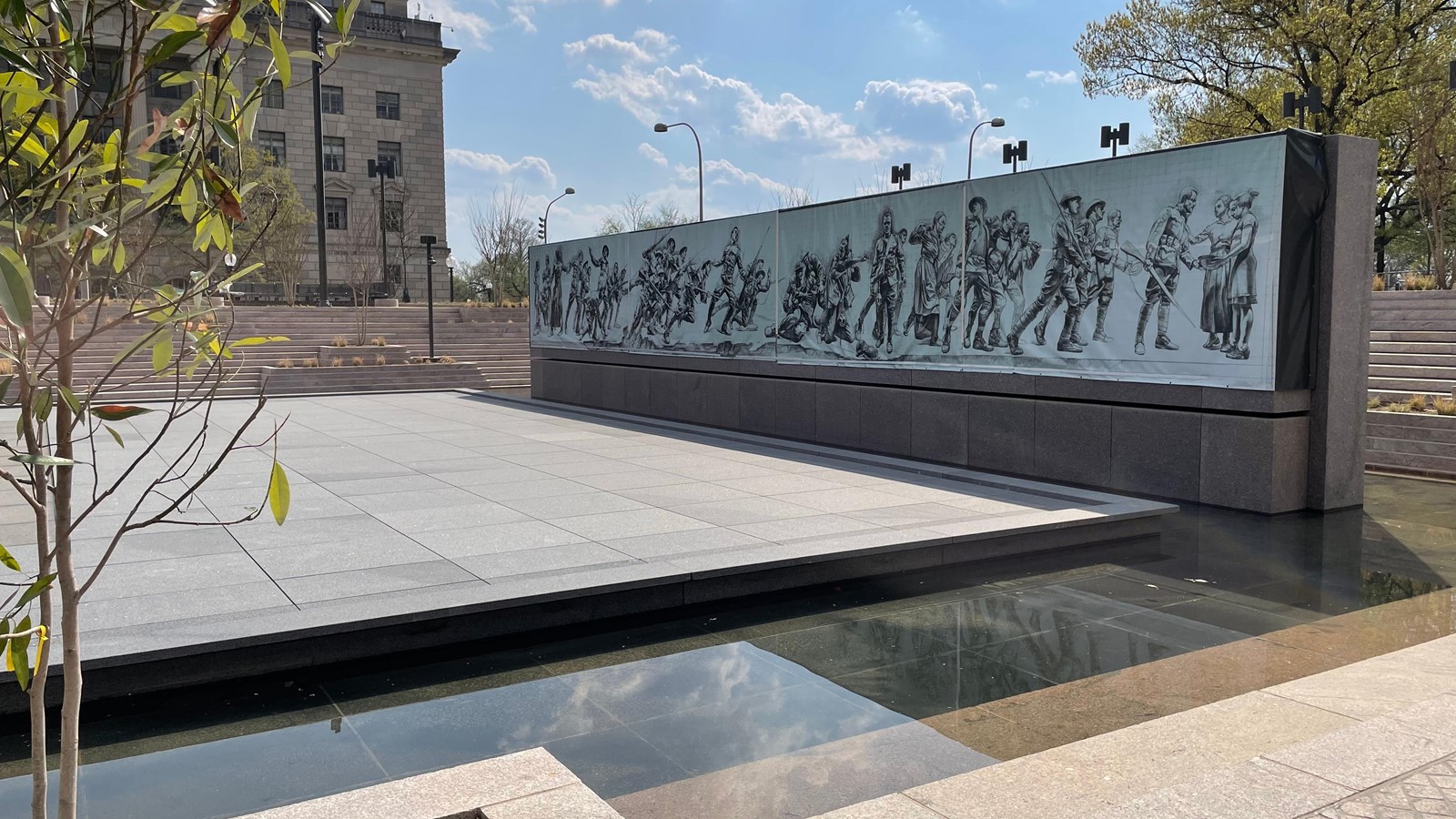Last updated: November 8, 2023
Place
World War I Memorial

NPS
Historical/Interpretive Information/Exhibits, Public Transit
The American flag was raised over the World War I Memorial for the first time on Friday, April 16, 2021 at the formal unveiling of the memorial that honors the 4.7 million Americans who served their nation in World War I, including 116,516 who made the supreme sacrifice.
Built by the United States World War I Centennial Commission and designed by architect Joseph Weishaar, the new memorial incorporates the existing memorial to Gen. John J. Pershing, commander of the American Expeditionary Forces during the war. The memorial also includes the Peace Fountain, a cascade of water behind an excerpt from the poem “The Young Dead Soldiers Do Not Speak” by Archibald MacLeish; engraved quotes and references to theaters, campaigns and battles in which American forces participated; and exhibits about the role of the United States in World War I.
The memorial’s central feature, a sculpture titled A Soldier’s Journey, is scheduled for installation in September 2024. The 58-foot-long bas-relief sculpture by Sabin Howard will feature 38 figures depicting the journey of a recurring American soldier and representing the larger American experience of World War I.
The memorial is located at the former Pershing Park, 1.76-acres along Pennsylvania Avenue NW between 14th Street NW and 15th Street NW, across from the White House Visitor Center. The World War I Memorial builds on the original design of Pershing Park, dedicated at the site in 1981 as the American Expeditionary Forces Memorial.
Sculpture - A Soldier's Journey
Memorial architect Joe Weishaar calls Sabin Howard’s A Soldier’s Journey sculpture “The Everyman.” Thirty-eight separate figures, spread over approximately 58 feet of wall towards the western end of the Memorial Core, portray the experience of one American soldier. Starting from the left, the soldier takes leave from his wife and daughter, charges into combat, sees men around him killed, wounded, and gassed, and recovers from the shock to come home to his family. The figures are mounted on the wall.
In the departure, the soldier’s daughter hand him his helmet, while his wife touches him with a restraining arm, as if to hold him back as he answers the call to battle – representing the debate over American involvement in the war. In the initiation, the soldier joins the parade to war, as the United States joins the epic battle in Europe.
The parade, and the work as a whole, includes African Americans and other ethnic groups who answered their country’s call.
In the middle scene, the ordeal, the parade devolves into the tension before the charge and then the tumult of desperate and violent combat. At the center our hero calls his comrades into battle, illustrating the famous American battle cry from Belleau Wood: “Come on, you sons of bitches, do you want to live forever?”
The aftermath depicts the physical and mental wounds of the fighters. Here are represented American women who served at home and on the fighting front. And here the turbulent, left-to-right narrative pauses, as the hero stops and looks directly at the viewer. The soldier’s look of shock and loss – the thousand-year stare – along with the empty helmets piled at his feet, invite the viewer to stop and contemplate with him the costs of war.
In the return, the soldier rejoins the homecoming parade. One figure look back with pride, while a flag bearer leads the country forward into “the American century.” Our soldier returns home and hands his helmet back to his daughter. She looks into the helmet and sees World War II, the war that will bring America back to Europe little more than 20 years later.
Due to the size and complexity of the casting process, the sculpture will not be installed September 2024. Until then, artwork showing what the final product will look like will be in its place. The wall is surrounded by water and is viewed from a platform several feet in front of it.
The Belvedere
A belvedere is an architectural feature providing a particularly scenic view. At the World War I Memorial, the Belvedere is the conceptual center of the memorial, as it provides a commanding view of the elements and features of the memorial – the American Expeditionary Forces memorial and General John J. Pershing statue is located to the viewer’s left, the A Soldier’s Journey sculpture is to the front, and flagstaff are and quotes from President Woodrow Wilson and others are to the right.
At the center of the Belvedere is a large rendering of the front of the World War I Victory Medal centered upon the memorial floor. The medal depicts a winged Victory holding a shield and sword on the front, heralding the dawn of a new era of peace.
Exhibit panels along the Belvedere wall describe the American accomplishments of the war, roles played by Americans of all forces and the legacy of the war.
Encircling the exterior of the Belvedere are listed the names of the campaigns in which U.S. forces participated during the war.
- Cambrai
- Somme Defensive
- Lys
- Aisne
- Montdidier-Noyon
- Champagne-Marne
- Aisne-Marne
- Somme Offensive
- Oise-Aisne
- Ypres-Lys
- Saint Mihiel
- Meuse-Argonne
- Vittorio Veneto
- North Russia
- Siberia
- Atlantic Convoys
- Western Atlantic
- North Sea
- Mediterranean
